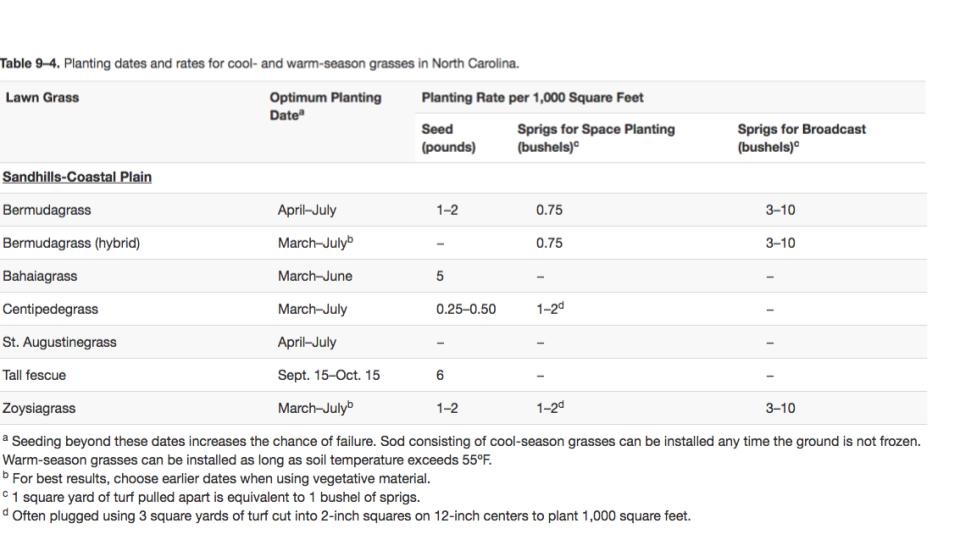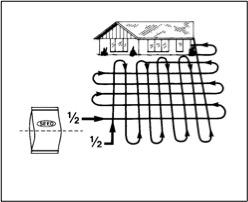Planting Warm-Season Grasses
go.ncsu.edu/readext?587604
en Español / em Português
El inglés es el idioma de control de esta página. En la medida en que haya algún conflicto entre la traducción al inglés y la traducción, el inglés prevalece.
Al hacer clic en el enlace de traducción se activa un servicio de traducción gratuito para convertir la página al español. Al igual que con cualquier traducción por Internet, la conversión no es sensible al contexto y puede que no traduzca el texto en su significado original. NC State Extension no garantiza la exactitud del texto traducido. Por favor, tenga en cuenta que algunas aplicaciones y/o servicios pueden no funcionar como se espera cuando se traducen.
Português
Inglês é o idioma de controle desta página. Na medida que haja algum conflito entre o texto original em Inglês e a tradução, o Inglês prevalece.
Ao clicar no link de tradução, um serviço gratuito de tradução será ativado para converter a página para o Português. Como em qualquer tradução pela internet, a conversão não é sensivel ao contexto e pode não ocorrer a tradução para o significado orginal. O serviço de Extensão da Carolina do Norte (NC State Extension) não garante a exatidão do texto traduzido. Por favor, observe que algumas funções ou serviços podem não funcionar como esperado após a tradução.
English
English is the controlling language of this page. To the extent there is any conflict between the English text and the translation, English controls.
Clicking on the translation link activates a free translation service to convert the page to Spanish. As with any Internet translation, the conversion is not context-sensitive and may not translate the text to its original meaning. NC State Extension does not guarantee the accuracy of the translated text. Please note that some applications and/or services may not function as expected when translated.
Collapse ▲The arrival of March signals the start of warm weather and the onset of yard work. One daunting task that begins this time of year is planting warm-season grasses. Warm-season grasses originate from the tropics and grow well in places with hot summers and mild winters. For this reason, warm-season grasses flourish here in the coastal plain of NC. These grasses will start to green in spring and proliferate throughout the summer and fall. The first hard frost causes the plants to go dormant and turn brown for the winter. Types of warm-season grasses include bermuda, zoysia, centipede, St. Augustine, carpet, and bahia. Planting dates and recommendations vary based on grass variety. A comprehensive table of warm-season grass planting dates can be found below.
Site Preparation. Lawns need to be prepared before planting to help ensure successful establishment of the new grass. Soil samples should be taken to determine soil pH and nutrient requirements. Soil should be taken at a depth of three to four inches at multiple spots in the yard and combined in a container. From these samples, place approximately one cup of soil in a soil sample box to send to the N.C. Department of Agriculture & Consumer Services Agronomic Division Soil Testing Services, 1040 Mail Service Center, Raleigh NC, 27607. Boxes and forms can be obtained at the N.C. Cooperative Extension Center, Currituck County Center.
Planting. Some types of warm-season grasses must be planted either by sod or other vegetative means because seeds either are not available or do not result in uniform stands. Seeding is the easiest and most economical method of establishing grasses. To ensure uniform coverage, use a rotary or drop-type spreader. Apply half the seed in one direction and the other half moving at right angles to the first pass (image below). Plugging is planting plugs (pieces of sod) on 6-inch or 12-inch centers. Sodding is placing sod stripped on the lawn for an “instant” lawn. Planting information can be found on the table above and at Extension Gardener Handbook: Lawns.
Maintenance. Newly seeded lawns require irrigation to promote germination. Lawns should be irrigated twice a day for the first two to three weeks. As the seedlings grow and root, water less often but for longer periods. Wait to mow the lawn until grasses are 50% higher than the desired height (table below). For example, bermuda is recommended to be mowed regularly at two inches; the first mow should be put off until the grass reaches three inches. After the third mow at the additional 50% height, the lawn is considered established and can be maintained at normal conditions.
More information on planting warm-season grasses and other lawn care issues can be found here: Extension Gardener Handbook: Lawns
If you have questions or concerns about lawn care or maintenance, or if you need assistance with soil samples email or call Adam Formella at adam_formella@ncsu.edu or 252-232-2262.







